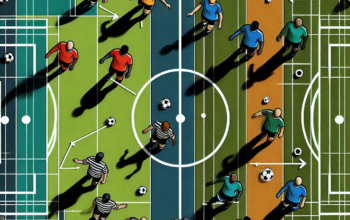The modern NBA has undergone a remarkable transformation in team dynamics over the past few decades, transitioning from a league dominated by individual talent to one where collective synergy and chemistry play pivotal roles in team success. This shift not only reflects changes in coaching strategies and player skill sets but also highlights the importance of analytics, communication, and integration of diverse talent. As of 2025, understanding the evolution of team dynamics in the modern NBA offers valuable insights into the future of basketball.
The Role of Analytics in Shaping Team Dynamics
Since the early 2000s, analytics have become a cornerstone in the NBA, fundamentally altering how teams operate and make decisions. Advanced metrics, such as Player Efficiency Rating (PER), Effective Field Goal Percentage (eFG%), and Win Shares, provide a comprehensive analysis of player contributions beyond traditional statistics. Teams have begun investing heavily in data science teams to interpret these analytics, guiding coaches in drafting strategies and optimizing player rotations. For instance, the emergence of “three-and-D” players, who prioritize shooting ability and defensive prowess, showcases how analytics influence roster construction and team playstyle, encouraging teams to adopt a more three-point-oriented offense.
Moreover, analytics also fosters collaboration among players and coaching staff. Teams now use data insights not only to assess individual performance but also to examine collective outputs—how various lineups perform together, addressing synergy in gameplay tactics. In 2025, franchises like the Golden State Warriors and the Boston Celtics exemplify this trend, deploying data-driven strategies that emphasize ball movement and efficient shot selection, leading to a more cohesive and agile approach on the court. This reliance on analytics has transformed team dynamics into a science, demanding players to adapt continuously and develop a versatile skill set.
The Rise of Player Empowerment and Its Impact
The concept of player empowerment has revolutionized the NBA landscape, profoundly influencing team dynamics. As players gain more agency in decision-making processes—from contract negotiations to team compositions—traditional hierarchies in franchises are being dismantled. The shift began in the mid-2010s as superstars like LeBron James and Kevin Durant took control of their narratives, actively participating in recruiting fellow athletes and shaping the teams they play for. By 2025, this trend has only intensified, allowing seasoned players to dictate team directions, leading to unconventional alliances, such as stars signing with each other to chase championships.
This player empowerment has redirected the focus from a singular star-driven approach to a more egalitarian model of teamwork. Teams equipped with multiple superstars, like the 2025 Los Angeles Lakers featuring a trio of All-Stars, must navigate the complexities of sharing leadership and responsibility on the court. This dynamic focus on collaboration emphasizes communication, with players openly discussing strategies and roles to build team chemistry. The modern NBA showcases that while talent is crucial, the willingness of players to sacrifice individual accolades for the team’s success is what defines great teams.
The Importance of Coaching in Modern Team Dynamics
The significance of coaching in shaping team dynamics cannot be overstated. Coaching styles have evolved in parallel with changes in analytics and player empowerment. Coaches are no longer solely tactical leaders but also mentors who guide players in the developing interpersonal relationships and fostering a positive culture. Coaches like Erik Spoelstra of the Miami Heat and Mike Budenholzer of the Milwaukee Bucks are known for emphasizing open communication, encouraging players to voice their ideas and concerns. This collaborative environment has cultivated teams that are more resilient and adaptable under pressure.
Today’s coaches are also more adaptable, implementing modern offensive and defensive systems that prioritize spacing, ball movement, and versatility. The incorporation of concepts like small-ball lineups and positionless basketball reflects this evolution, requiring players to be skilled in multiple roles. Coaches must balance experimentation with consistency, ensuring that players remain cohesive despite frequent roster adjustments. The dynamic between players and coaches in 2025 exemplifies a shift towards a mentorship approach, where players evolve into leaders under guidance, transforming the dynamics of the entire team.
The Integration of Technology in Team Dynamics
Technology has effectively revolutionized NBA teams, not only improving game performance but also enhancing team cohesion. Since the early 2000s, the integration of advanced video analysis has transformed coaching strategies. Coaches utilize software programs such as Synergy Sports Technology to break down game footage, allowing for an in-depth examination of plays and player movements. This technology empowers players to analyze their performances and understand their roles in various situations, thus enhancing overall team synergy.
In 2025, teams are employing even more sophisticated tools, such as wearables and virtual reality (VR) training systems, to monitor player health and refine skill sets. These technologies allow teams to analyze fatigue levels, recovery timelines, and improve individual performance. By enhancing the training processes and injury prevention methods, technology fortifies team dynamics, ensuring that players are at their peak capacity for performance. In turn, this collective focus on health and development fosters a productive atmosphere, enabling players to bond over shared goals and experiences firsthand.
The Future of Team Dynamics in the NBA
As we look to the future of team dynamics in the NBA, one can expect continued evolution driven by emerging trends. The sport is increasingly embracing globalization, with international players bringing diverse skills and perspectives to NBA rosters. As teams expand their scouting and development efforts in Europe, Asia, and beyond, the infusion of global talent will further redefine how teams function and collaborate. Empowering these players within established team structures will be essential for fostering inclusivity and maximizing their potential.
Additionally, the role of mental health and wellness is increasingly seen as vital for team dynamics. By 2025, organizations recognize that supporting players’ mental well-being directly affects performance and team morale. Incorporating psychologists, life coaches, and wellness programs into teams’ infrastructures promotes healthier environments, allowing players to thrive both on and off the court. Therefore, teams that prioritize mental wellness will likely build stronger, more cohesive units that are equipped to face challenges collectively.
Finally, as the NBA continues to adapt to social changes, the relationships among players, coaches, and management will significantly shape the league’s future. Franchise owners and executives are learning that transparency and empathy facilitate stronger partnerships, improving team dynamics. Creating an ecosystem where every member feels valued will be pivotal for long-term success. Thus, the evolution of team dynamics in the modern NBA promises exciting developments, as stakeholders navigate these relatively new challenges together.
Conclusion:
The evolution of team dynamics in the modern NBA is an intricate tapestry woven from analytics, player empowerment, coaching influence, technology integration, and future trends. Understanding these layers provides insights into current team structures and future directions the league may take. As we advance into the new era of basketball, the emphasis on collective success over individual glory will define the teams capable of achieving great heights in the ever-competitive landscape of the NBA.
FAQs
What are the main factors influencing team dynamics in the NBA?
Team dynamics in the NBA are primarily influenced by analytics, player empowerment, coaching styles, technology integration, and an emphasis on mental wellness.
How has analytics changed team strategies in the NBA?
Analytics have revolutionized team strategies by providing insights that help coaches make informed decisions on player performance, roster construction, and game-winning strategies, focusing on efficiency and collaborative play.
What does player empowerment mean for team dynamics?
Player empowerment refers to the growing influence of players in decision-making processes, impacting team compositions and strategies, leading to a culture where collaboration and shared leadership are emphasized.
In what ways is technology integrated into team dynamics today?
Technology in modern NBA teams includes advanced video analysis, wearables for performance monitoring, and virtual reality training systems, which enhance player development, performance efficiency, and team cohesion.
What can we expect for the future of team dynamics in the NBA?
The future of team dynamics will likely involve further globalization of talent, increased emphasis on mental health and wellness, and stronger relationships among players, coaches, and management for better collaboration.
This article provides a comprehensive overview of the evolution of team dynamics in the modern NBA, emphasizing the interconnectedness of various factors that contribute to on-court success in 2025 and beyond.






